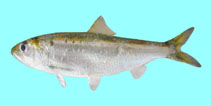| Family: |
Alosidae (Shads and Sardines) |
| Max. size: |
30 cm TL (male/unsexed); max.weight: 59.0 g |
| Environment: |
pelagic-neritic; freshwater; brackish; marine; depth range 50 - 70 m, anadromous |
| Distribution: |
Eurasia: Black Sea and Sea of Azov from where adults ascend rivers, migrating a short distance upstream to spawn. |
| Diagnosis: |
Distinguished from its congeners entering freshwater in Black Sea basins by having 66-96 gill rakers, longer than branchial filaments and poorly-developed teeth on palatine and vomer (Ref. 59043). |
| Biology: |
This species migrates from sea to mouth and lower reaches of large rivers (at 1-2 years) and spawns in fresh or slightly brackish water, usually close to the shore, upper 2-4 m, in almost still water bodies as flood plains or lakes. Many individuals spawn 2-4 seasons and spawners appear along the coast in late January to March, enter rivers when temperature reaches about 10°C in late April to May, and spawns at about 15°C or beyond in May to June. Eggs are bathypelagic or sink to bottom. Spent fish migrate to estuarine and coastal lagoons or to sea near river mouths to feed and in autumn, move to sea near river mouths to overwinter. Juveniles migrate to sea or estuaries during first summer and remain there until maturity. At sea, feeds on a wide variety of zooplankton (crustaceans), insect larvae and small fish. Populations seem to have stabilized at moderate level after most have declined during the first decades of 20th century due to water pollution. In northern Black Sea, immediate impact is foreseen due to the decline in habitat quality in suitable estuarine ecosystems. On the other hand, the species is still abundant in Azov Sea basin (Ref. 59043). |
| IUCN Red List Status: |
Least Concern (LC); Date assessed: 01 January 2008 Ref. (130435)
|
| Threat to humans: |
harmless |
Source and more info: www.fishbase.org. For personal, classroom, and other internal use only. Not for publication.
